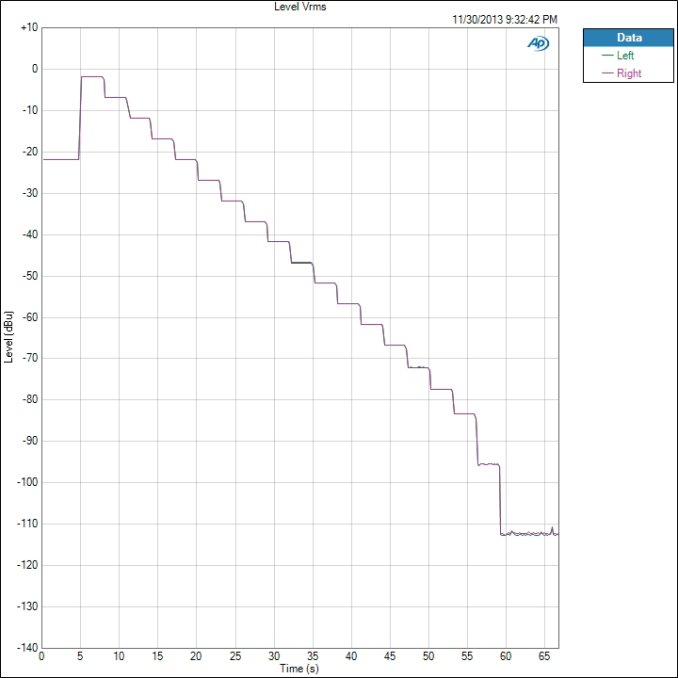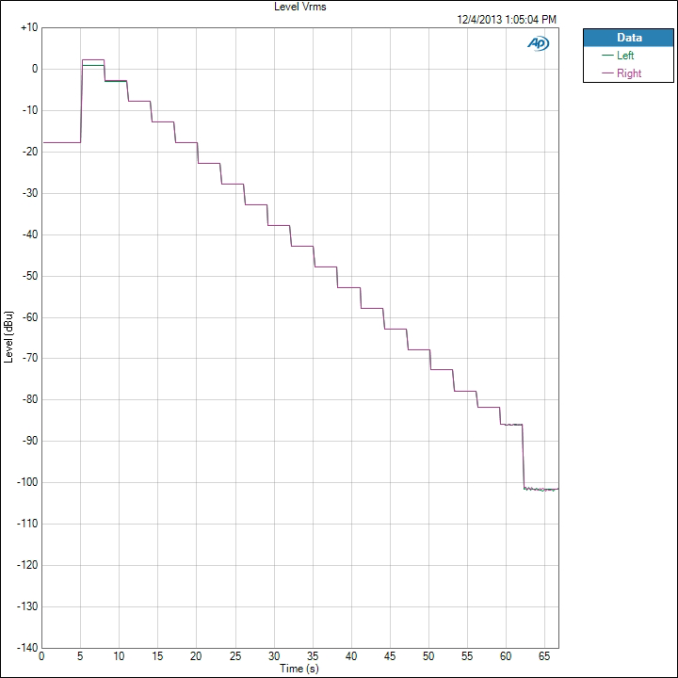Smartphone Audio Quality Testing
by Chris Heinonen on December 8, 2013 5:15 PM EST- Posted in
- Smartphones
- Audio
- Mobile
- Tablets
- Testing
Dynamic Range
The dynamic range of the phone indicates the difference between the loudest possible sound and the background noise. The more residual noise in the background, the lower the dynamic range. Phones with more powerful amplifier sections will typically produce a greater dynamic range. The residual noise level is often constant, so as the overall volume level increases the difference between the music and the noise increases as well.
The best performer here is the iPhone 5 again, with 92.214 dB of range. The worst is the Nexus 5 with only 89.332 dB. A difference of 3 dB is not something I would concern myself over. If we see a phone or tablet that drops down below 80 dB then I will start to show more concern.
Crosstalk
Crosstalk, like dynamic range, is just a number here. This is the measurement how much signal leaks from one channel into another. If an instrument should only be in the right ear, some of that signal will leak into the left ear, but we want that as low as possible. The results are expressed in -dB, or how much quieter one ear is than the intended ear.
On the Note 3 we see a wonderful crosstalk measurement of -117.2 dB so the sounds in one ear are -117 dB quieter in the other ear. This makes them impossible to hear. The worst is the iPhone 5, with only -75.624 dB of isolation.
Stepped Response
The stepped response uses a 1 kHz 0 dBFS tone but measures output level from maximum volume to minimum volume. We can see how large the volume steps are and how many there are. It doesn’t produce a number we can use, but it ties back into our other results. For a good example, we can look at the Note 3.
We see steps that are around -5 dBu each. The final level is muted and just the background noise of the device. Each step is clean and even but as we get lower and lower we see noise start to intrude. This is the background noise starting to become audible in the signal. The flatter the levels are, the quieter it will be. Now, let us look at the Nexus 5.
Notice at the very top how the right and left channels do not overlap. That is the clipping we talked about at the very beginning. It isn’t until the 4th volume setting that the level difference is down to nothing. Because of this, I would consider the top 3 volume settings of the Nexus 5 as ones that should be avoided. They each have enough THD+N introduced into them that it will sound poor, and one ear will be louder than the other.












188 Comments
View All Comments
Impulses - Monday, December 9, 2013 - link
All great suggestions IMO.haukionkannel - Tuesday, December 10, 2013 - link
I allso agree. Maximum volume level is not the same as guality, you have to find measures that are relevant in normal listening volumes. They vary yeas and depends a lot of used headphones. So I would allso recommended of using headphones with different impedanses! One pair of high impedance hifi headphones. One pair of low impedance hifi headphones and one pair of high guality (but commonly used) low impedance headphones.Otherwise it would be like testing 780 triple sli setup using 320p resolution mini monitor...
(Well actually not likely because phones have not been very high guality sound sourses, but I think that you got the point.) Good sound qaulity is important factor to me, so I am very eager to hear more (pun inteded ;-) about these test and allso the results!
DaveSimmons - Monday, December 9, 2013 - link
Thanks for doing this. When my 120 GB iPod dies I'll probably replace it with a smartphone or tablet, so this will help me choose which one to use.estarkey7 - Monday, December 9, 2013 - link
As others have stated, and I will reiterate, Only Anandtech! Bravo!I would love to see a similar article comparing HD Voice for the carriers. I know that test may be more difficult to conduct, but ever since Sprint hyped their HD Voice and didn't deliver, I'd like to see some real engineers do the topic justice.
hlovatt - Monday, December 9, 2013 - link
Congratulations AnandTech, yet again you show the rest of the review industry what they should be doing. Keep up the good work and it should be fascinating to see the full set of results. Thanks.willis936 - Monday, December 9, 2013 - link
Is there any comment on the practical issue of noise at low volumes? Noise floor testing is uncommon but phones are noisy and are typically listened to with sensitive buds. Who cares it'd the dynamic range is 100dB if you never turn the volume up past 30%?pr1mal0ne - Monday, December 9, 2013 - link
I disagree with you testing all phones at maximum volume level1) the max volume differs, some companies may reasonably make the choice to let quality suffer while volume improves. at the least volume needs to be reported alongside these quality discussions. Preferably it would be set to a base volume and tested there.
Tuxedo - Monday, December 9, 2013 - link
Amazing article. I have always been impressed with audio quality on iPhones and disappointed with GS2, GS3, Atrix, Lumia 900 and now OG-Pro. Really shows how much attention Apple pays to the products they build.edwh - Monday, December 9, 2013 - link
what about output impedance?fishjunk - Monday, December 9, 2013 - link
I don't really use the audio jack on my Nexus 5. Are there any tests done on the phone mic and speakers.